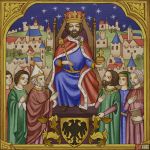Text
Not only a geographical area of countries following the glory of Rome after its collapse, but also a socio-political power formation with a great symbolic value. It was not a unified state, but a very loose union of many different states. Officially, the empire functioned from 962 until 1806, its size and member states changing frequently. The emperors of the Holy Roman Empire were elected by the so-called prince-electors until the 15th century, when the Habsburg dynasty claimed the imperial throne hereditarily. The coronation of an emperor was accompanied by many political struggles, especially on the part of the Church, which claimed the so-called investiture for itself and wanted to be indispensable in this activity. Thus, each emperor had to accept his title from the hands of the Pope.
The Bohemian Principality became part of the Empire in the early 11th century, but thanks to Přemysl Otakar I., the Bohemian lands had a special status within the confederation: the Bohemian monarch was exempt from all obligations to the Holy Roman Empire, except for participation in the councils. The first Bohemian monarch to sit on the imperial throne was ![]() Charles IV.
Charles IV.


No Comments